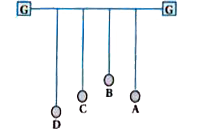Complete Solutions to SECTION-D (NCERT EXEMPLAR SOLUTION MCQs) of chapter OSCILLATIONS of Class 11 book with complete answers and questions
| Class 11 | PHYSICS |
| Chapter | OSCILLATIONS |
| KUMAR PRAKASHAN | SECTION-D (NCERT EXEMPLAR SOLUTION MCQs) |
| Number Of Questions | 10 |
| Academic Year | 2023-24 |
The displacement of a particle represented by the equation `y= 3 cos((pi)/(4)-2 omega t)`. The motion of the particle is
View SolutionThe displacement of a particle is represented by the equation `y= sin^(3) omega t`. The motion is………..
View SolutionThe relation between acceleration and displacement of four particle are given below, which one of the particle is exempting simple harmonic motion?
View SolutionMotion of an oscillating liquid column in a U-tube is……..
View SolutionA particle is acted simultaneouosly be mutually perpendicular simple harmonic motion `x= a cos omega t" and "y= a sin omega t`. The trajectory of motion of the particle will be………
View SolutionThe displacement of a particle varies with time according to the relation `y= a sin omega t+b cos omega t`……………
View SolutionFour pendulums A, B, C and D are suspended from the same elastic support as shown in figure. A and C are of the same length, while B is smaller than A and D is larger them A. If A is given a transverse displacement,

View SolutionFigure shows the circular motion of a particle. The radius of the circle, the period, sense of revolution and the initial position are indicated on the figure. The simple harmonic motion of the x-projection of the radius vector of the rotating particle P is..........

View SolutionThe equation of motion of a particle is `x= a cos (alpha t)^(2)`. The motion is………..
View SolutionA particle executing SHM has a maximum speed of `30 cm"/"s` and a maximum acceleration of `60 cm"/"s^(2)`. The period of oscillation is………..
View Solution
SECTION-D (NCERT EXEMPLAR SOLUTION MCQs) questions and complete solutions for chapter OSCILLATIONS of KUMAR PRAKASHAN KENDRA PHYSICS (GUJRATI ENGLISH) of Class 11
All Exercises from KUMAR PRAKASHAN Class 11 PHYSICS OSCILLATIONS
- QUESTION PAPER (SECTION - A)
- QUESTION PAPER (SECTION - B)
- QUESTION PAPER (SECTION - C)
- QUESTION PAPER (SECTION - D)
- SECTION-A (QUESTIONS- ANSWERS)
- SECTION-A (TRY YOURSELF)
- SECTION-B (ADDITIONAL EXERCISE)
- SECTION-B (NUMERICAL FROM DARPAN BASED ON TEXTBOOK)
- SECTION-B (NUMERICAL FROM TEXTUAL EXERCISE)
- SECTION-B (NUMERICAL FROM TEXTUAL ILLUSTRATIONS)
- SECTION-C (OBJECTIVE QUESTIONS ASSERTION OR REASION)
- SECTION-C (OBJECTIVE QUESTIONS FILL IN THE BLANK)
- SECTION-C (OBJECTIVE QUESTIONS MATCHING)
- SECTION-C (OBJECTIVE QUESTIONS TRUE OR FALSE)
- SECTION-C (OBJECTIVE QUESTIONS)
- SECTION-D (NCERT EXEMPLAR SOLUTION LONG ANSWER QUESTIONS)
- SECTION-D (NCERT EXEMPLAR SOLUTION MCQs MORE THAN ONE OPTIONS)
- SECTION-D (NCERT EXEMPLAR SOLUTION MCQs)
- SECTION-D (NCERT EXEMPLAR SOLUTION SHORT ANSWER QUESTIONS)
- SECTION-D (NCERT EXEMPLAR SOLUTION VERY SHORT ANSWER QUESTIONS)
- SECTION-E (MCQs ASKED IN GUJARAT BOARD AND COMPETITIVE EXAMS)
- SECTION-F (QUESTIONS FROM MODULE SIMPLE QUESTIONS)